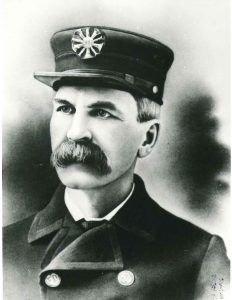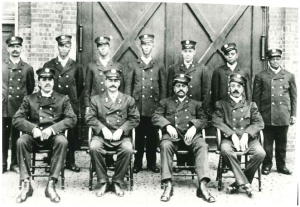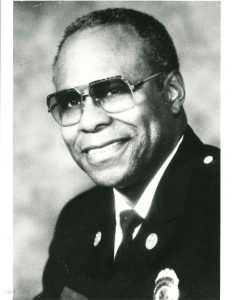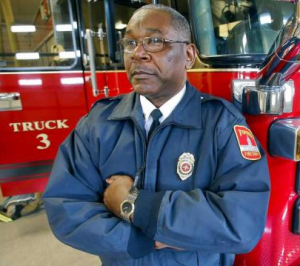Fire Station No. 3 of Topeka, KS, 1882-1963
Content

First Fire Chief of Topeka, KS
On a Saturday morning on February 2, 1908, firemen rushed to the Rock Island depot at 1st and Kansas to put out a fire. Bystanders watched men from multiple fire stations combat the raging inferno, including Fire Station No. 3, the first station made up entirely of black men.
In September of 1882, Topeka officials made the decision to conduct an experiment involving a fire station being made up of all black men. People had their doubts, including Topeka’s first Fire Chief George O. Wilmarth, but later, in Topeka newspaper The Plaindealer, Chief Wilmarth was described as “fair and like a father to the boys.”
The station was located at 312 SE Jefferson and was built in the same year Station No. 3 began. The building has since been torn down, during the Urban Renewal period, around 1958. Oscar K. Swayze, who wrote a historical piece about the early fire stations of Topeka, claimed it was the first such station in Topeka, and even the first in the United States.
Some of the original men assigned to Station No. 3 included Frank McKinley, who was its first captain; George H. Moss, who served as lieutenant and secretary by 1900; and Kirk K. Pinkston, a strong advocate of black rights. He wrote an article in The Plaindealer calling readers to establish themselves in the community, to demonstrate to whites that black people are not a problem but an asset and to contribute to society.

Fire Station No. 3, ca. 1915
In the photograph to the left are the men assigned to Station No. 3 around 1915. Beginning in the front row from the left is J. Watson, Captain Louis Knott, Lieutenant James W. Washington, and hoseman Silas Brown. In the back row from the left is John H. Rhodes, William M. Hatcher, Samuel J. McCombs, William M. Frazier, Arthur S. Clark, Tom Forte, and Mr. Miles.
Within two years after this picture was taken Mr. Clark drowned while off duty in Wakarusa creek. He was 27 years old and had been a part of Station No. 3 for more than six years. Clarence Jackson was promoted a year later, from being an extra to assuming Mr. Clark’s position.
On March 8, 1926, after 6:00 PM, fireman Silas Brown was killed while on duty, having fallen from an aerial truck as they were driving to a fire at 618 W Norris. His team believed he had suffered a heart attack, having heard him complain he had not been feeling well for the previous few days. He had served as a fireman for almost 25 years.
From the beginning, Fire Station No. 3 of Topeka was reputed to being the best and the fastest of all the stations, and the men who came and went over the decades worked hard to keep that reputation they, and the black community, were so proud of.
It is unclear where Station No. 3 staff were assigned between the time the building at 312 SE Jefferson was torn down in 1958 to when segregation ended among the fire stations in 1963. Bert E. Line, fire chief at the time and an opponent of integrating, assigned two men from Station No. 3 to each other fire station on opposite shifts, in order that they would not share the same beds with their white colleagues. For the former members of No. 3, integration was a disappointment. The men lost the camaraderie they had with each other, which they did not find at the other fire stations, and promotions were not offered to them so they could rise through the ranks.

Fire Chief Joe Douglas Jr.
There is a mystery as to what the officials were testing and looking for when they began this experiment in 1882. Did they question a black man’s abilities? If he would be beneficial to the fire department? Six decades after the experiment began, a young black man named Joe Douglas Jr. joined Station No. 3 on October 15, 1950. Twenty years later, Mr. Douglas Jr. became the first black Fire Chief of Topeka. He retired in 1989.
On June 10, 1985 Greg Bailey joined the fire department and was the second black fire chief from 2012 until he retired in 2016.

Fire Chief Greg Bailey (2016)
African American Builders of Topeka
We are creating a community driven exhibit showcasing the ordinary and extraordinary stories of African-Americans in Topeka and Shawnee County. Come visit the exhibit when it opens on January 19, 2018! Find newspaper articles and writings about African-Americans in the Topeka Room and our online databases.
Articles and images are from Topeka’s The Plaindealer, Newspapers.com (available through the Kansas Historical Society), and our Topeka Room’s Vertical Files.












